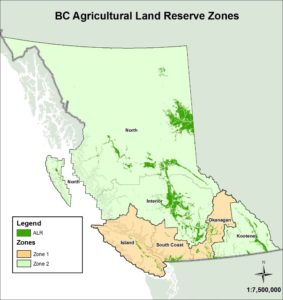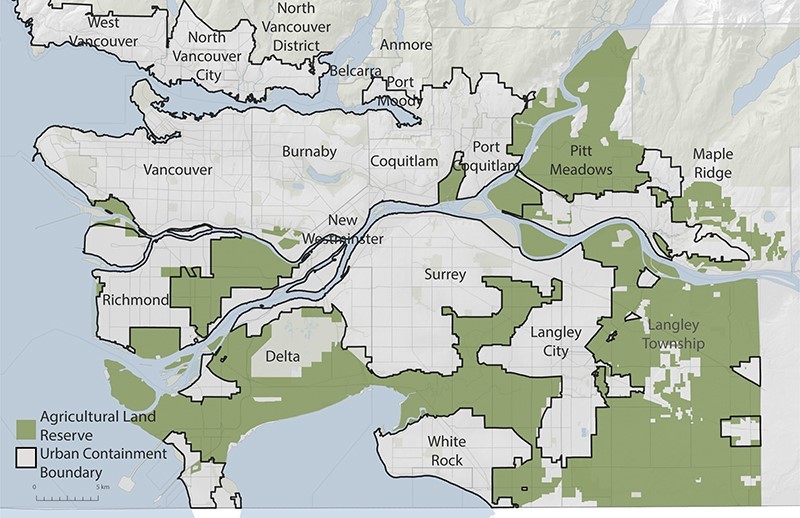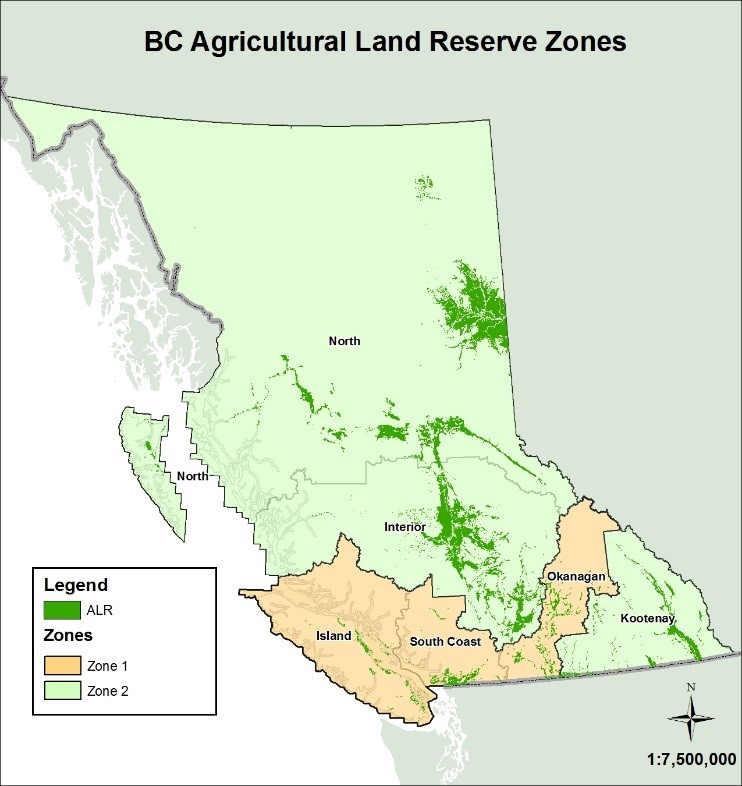To what extent should we support ARL?
By Lindsay Pollard, University of Saskatchewan student
British Columbia’s Agricultural Land Reserve (ALR) was put into place in 1973 to protect the 3.9% of the province’s agriculturally capable land and there has been a division between those for and against it ever since. Some say that the ALR prohibits urban growth while others say it’s needed to maintain what little agricultural land the province has.
 BC’s ARL is governed by the provincial government’s Agricultural Land Commission (ALC). When the Agricultural Land Commission Act was enacted, the province was divided into 6 ‘panel regions’, each having one representative or “vice-chair” on the Commission. Recently the province has been organized into two zones, each containing 3 regions. Zone 1 follows the original purpose, encouraging farming and preserving agricultural land. Zone 2 is similar but takes into account regional planning and social values, which allows for succession planning. The Commission has the authority to decide what land is under the ALR. Anyone who wishes to add to or remove land from the ALR has to apply to the Commission which then decides if the application follows the intent of the act or if the benefits of the land being removed from the reserve are higher than it remaining and approve it. To make such a decision the commission votes at their meetings. Each year the Commission processes and votes on 500 – 700 new land use applications including both applications to add and remove land.
BC’s ARL is governed by the provincial government’s Agricultural Land Commission (ALC). When the Agricultural Land Commission Act was enacted, the province was divided into 6 ‘panel regions’, each having one representative or “vice-chair” on the Commission. Recently the province has been organized into two zones, each containing 3 regions. Zone 1 follows the original purpose, encouraging farming and preserving agricultural land. Zone 2 is similar but takes into account regional planning and social values, which allows for succession planning. The Commission has the authority to decide what land is under the ALR. Anyone who wishes to add to or remove land from the ALR has to apply to the Commission which then decides if the application follows the intent of the act or if the benefits of the land being removed from the reserve are higher than it remaining and approve it. To make such a decision the commission votes at their meetings. Each year the Commission processes and votes on 500 – 700 new land use applications including both applications to add and remove land.
The ALC manages ALR regulations, specifying what land uses are considered agricultural and are permitted. In addition, they regulate packaging plants and retail sales on agricultural land, including road and railway development. The Commission has developed land capability classes for the soils within the province to help determine what land should be in the ALR. However, there is no mention in the regulations as to how these classes affect any applications to take land out of the ALR. In the early 1970’s the ALR protected 4.7 million hectares, today it protects 4.6 million hectares, indicating that it has been successful in protecting BC’s agricultural land.
Many industries in the metro Vancouver area want to develop on land currently zoned under the ALR. One area that has drawn attention is the Metro Vancouver Port which is looking to rezone 236 acres of ALR protected land to expand port operations. The municipal districts don’t want this land redeveloped for Port activities, but to remain under the ALR. However, Port expansion is needed to increase the efficiency of Canadian commodity movements, making the fight that much more complicated.
 With a growing population, the need for local food is important in BC. The way to keep this amount of land for farming is through the ALR. Many say that it’s preventing urban growth but I disagree, the size of the metro Vancouver continues to grow despite how land is classified. However, not all of ALR land is being farmed and the expansion of Port operations or other agricultural innovation should be considered for this land. Rather than preserving land for agriculture and letting ALR land sit idle, the Commission should ensure that anyone owning ALR land must use it for one of the acceptable uses. Currently, the Port of Metro Vancouver holds 236 acres of unutilized ALR land. This is a decent chunk of land that, in my opinion, could be being used right now for food production. The ALR is a great way to keep what little land for agriculture BC has from being developed and should be supported.
With a growing population, the need for local food is important in BC. The way to keep this amount of land for farming is through the ALR. Many say that it’s preventing urban growth but I disagree, the size of the metro Vancouver continues to grow despite how land is classified. However, not all of ALR land is being farmed and the expansion of Port operations or other agricultural innovation should be considered for this land. Rather than preserving land for agriculture and letting ALR land sit idle, the Commission should ensure that anyone owning ALR land must use it for one of the acceptable uses. Currently, the Port of Metro Vancouver holds 236 acres of unutilized ALR land. This is a decent chunk of land that, in my opinion, could be being used right now for food production. The ALR is a great way to keep what little land for agriculture BC has from being developed and should be supported.
Lindsay Pollard
Lindsay has just finished her third year in the College of Agriculture and Bioresources at the University of Saskatchewan, and this fall she will be starting her fourth and final year of her Agribusiness degree. Originally from Sidney, British Columbia, Lindsay spent much of her childhood running around her cousin’s cattle farm. She says she is interested in agriculture policy, especially the effects it has on industry and consumers. One day she hopes to end up working in a position analyzing policy or creating it.


